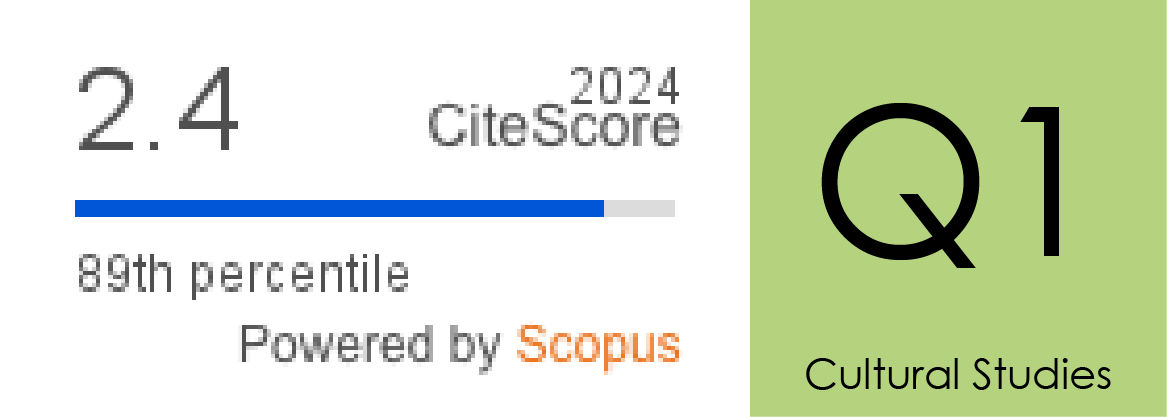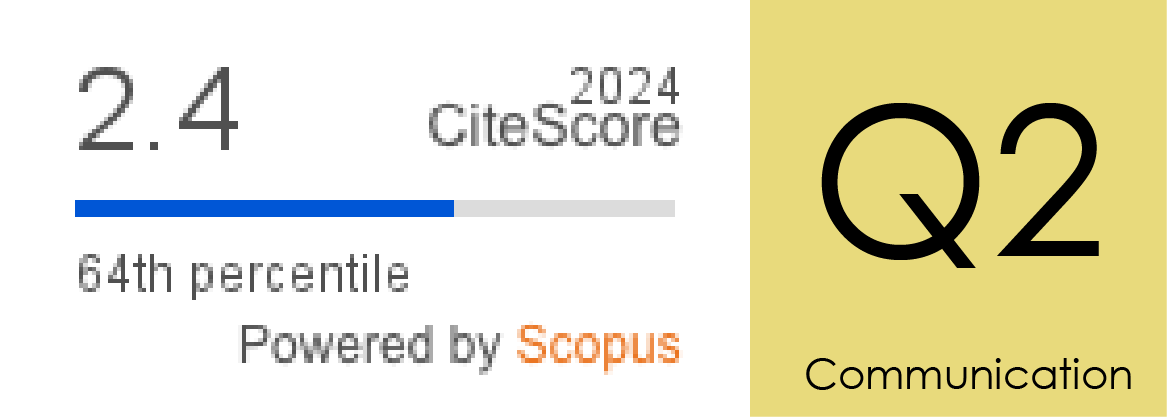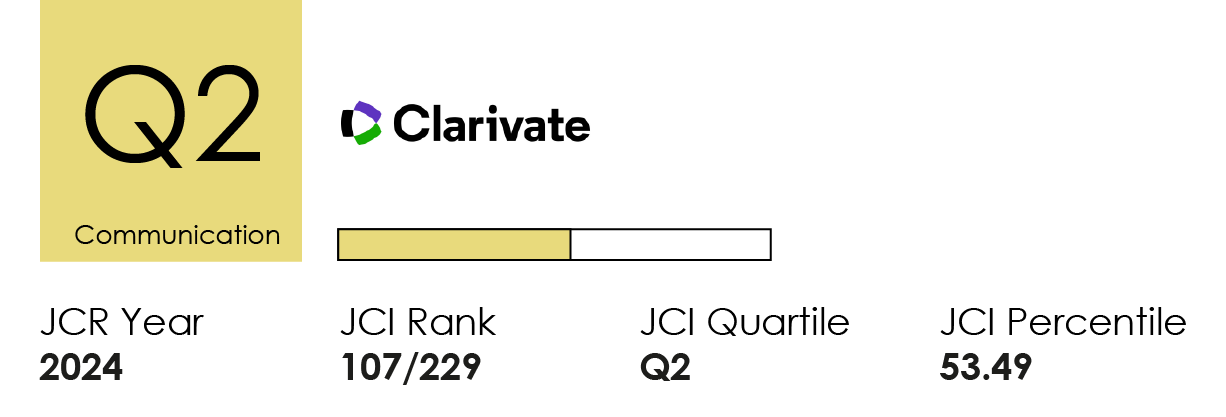Actores periféricos y periodismo en Twitch: análisis de la calidad de los contenidos informativos en live streaming
DOI:
https://doi.org/10.14198/MEDCOM.27480Palabras clave:
Twitch, media interlopers, actores periféricos, Periodismo, livestreamingResumen
Las formas en las que el periodismo y las redes sociales se relacionan se han vuelto cada vez más complejas. En este contexto, destaca un fenómeno que ha auspiciado la participación de los usuarios en el debate público: la retransmisión en directo de contenidos informativos por parte de actores periféricos en Twitch. El objetivo de esta investigación es analizar mediante entrevistas semiestructuradas y análisis de contenido el lenguaje, formato y estructura de cuatro streamers en Twitch y medir la calidad, las similitudes y las diferencias en función de si intervienen periodistas profesionales o no. Las cuentas de Twitch analizadas muestran diferencias formales y de enfoque entre los periodistas y los actores periféricos. Sin embargo, es posible identificar un cierto grado de continuismo entre ambos. Asimismo, las características propias de la plataforma, así como sus códigos y lenguajes, condicionan la actividad periodística, promueven la participación del público y la dotan de un carácter más informal, en ocasiones, incumpliendo los criterios de calidad en la labor informativa.
Citas
Arroyo-Cabello, M. (2011). Aproximación al perfil del periodista en la postmodernidad. Razón y Palabra, (76). https://shre.ink/gjVK
Buan, Y. (2022). The Parasocial Problem with Livestreaming: The Distorted Reality it shapes for its Streamers and Viewers. https://bit.ly/4dLFITC
García-Canclini, N. (2011). Qué queremos decir con diversidad y calidad en los medios. Derecho a comunicar, (2), 1-12. https://shre.ink/gjVG
Carlson, M. (2016). Metajournalistic Discourse and the Meanings of Journalism: Definitional Control, Boundary Work, and Legitimation. Communication Theory, 26(4), 349−368. https://doi.org/10.1111/comt.12088
Carlson, M., & Lewis, S.C. (2015). Boundaries of Journalism: Professionalism, Practices and Participation. Routledge. https://doi.org/10.4324/9781315727684
Carvajal, M., Mondéjar, D., Valero-Pastor, J. M., De-Lara, A., García-Avilés, J. A., & Arias-Robles, F. (2022). Las innovaciones periodísticas más destacadas en España (2010-2020): características e impacto organizacional, industrial y social. Profesional De La información, 31(3). https://doi.org/10.3145/epi.2022.may.04
Claessens, N., & Van den Bulck, H. (2015) Parasocial relationships with audiences’ favorite celebrities: The role of audience and celebrity characteristics in a representative Flemish sample. Communications, 40(1), 43−65. https://doi.org/10.1515/commun-2014-0027
Cohen, B. (1963). The Press and Foreign Policy. Princeton University Press.
Deuze, M. (2005). What is journalism?: Professional identity and ideology of journalists reconsidered. Journalism, 6(4), 442−464. https://doi.org/10.1177/1464884905056815
Eldridge, S. (2014) Boundary Maintenance and Interloper Media Reaction: Differentiating between journalism’s discursive enforcement processes. Journalism Studies, 15(1), 1−16. https://doi.org/10.1080/1461670X.2013.791077
Eldridge, S. (2016) The Digital Journalist: The journalistic field, boundaries, and disquieting change. In, The Routledge Companion to Digital Journalism Studies. Routledge.
Foxman, M., Harris, B. C., & Partin, W. C. (2024). Recasting Twitch: Livestreaming, Platforms, and New Frontiers in Digital Journalism. Digital Journalism, 12(4), 516−536. https://doi.org/10.1080/21670811.2024.2329648
García-Avilés, J.A. (1996). Periodismo de calidad. Estándares informativos en la CBS, NBC y ABC. Ediciones Universidad de Navarra.
García-Ortega, A., y García-Avilés, J.A. (2018). Los newsgames como estrategia narrativa en el periodismo transmedia: propuesta de un modelo de análisis. Revista Mediterránea De Comunicación, 9(1), 327−346. https://doi.org/10.14198/MEDCOM2018.9.1.19
Gladney, G. A. (1990). Newspaper excellence: How editors of small and large papers judge quality. Newspaper Research Journal, 11(2), 58−72. https://doi.org/10.1177/073953299001100206
Gómez-Mompart, J.L. (2013). Complejidad social y calidad informativa: Hacia un periodismo “glocal”. Austral Comunicación, 2(2), 219−238. https://doi.org/10.26422/aucom.2013.0202.gom
González-López, R., Negreira-Rey, M.C., & Vázquez-Herrero, J. (2024). Periodismo en Twitch: análisis exploratorio de las primeras iniciativas informativas. Revista De Comunicación, 23(1), 221−258. https://doi.org/10.26441/RC23.1-2024-3433
Gutiérrez-Lozano, J.F., & Cuartero, A. (2022). La construcción mediática de los ídolos juveniles de Twitch: los creadores de contenido y su presencia creciente en los medios españoles. AdComunica, (23), 251−274. https://doi.org/10.6035/adcomunica.5936
Hamilton, W., Garretson, O., & Kerne, A. (2014). Streaming on Twitch: Fostering participatory communities of play within live mixed media. In, Proceedings of the 32nd annual ACM Conference on Human Factors in Computing Systems. https://doi.org/10.1145/2556288.2557048
Hanitzsch, T., & Örnebring, H. (2019). Professionalism, Professional Identity, and Journalistic Roles. In, The handbook of journalism studies. Routledge.
Hanitzsch, T. (2007). Deconstructing journalism culture: Toward a universal theory. Communication Theory, 17(4), 367−385. https://doi.org/10.1111/j.1468-2885.2007.00303.x
Hanusch, F., & Löhmann, K. (2022). Dimensions of Peripherality in Journalism: A Typology for Studying New Actors in the Journalistic Field. Digital Journalism, 11(7), 1292−1310. https://doi.org/10.1080/21670811.2022.2148549
Hermida, A, & Young, M. (2019). From Peripheral to Integral? A Digital-Born Journalism Not for Profit in a Time of Crises. Media and Communication, 7(4), 92−102. https://doi.org/10.17645/mac.v7i4.2269
Hermida, A, & Thurman, N. (2008). A clash of cultures. Journalism Practice, 2(3), 343−356. https://doi.org/10.1080/17512780802054538
Holton, A., & Belair-Gagnon, V. (2018). Strangers to the Game? Interlopers, Intralopers, and Shifting News Production. Media and Communication, 6(4), 70−78. https://doi.org/10.17645/mac.v6i4.1490
Israel-Garzón, E., & Pomares-Pastor, A. (2015). Indicadores de calidad para analizar la información televisiva sobre grupos minoritarios. El caso de “El ángel rubio”. Contratexto, 24(024), 249−269. https://doi.org/10.26439/contratexto2015.n024.595
Jenkins, H. (2006). Fans, bloggers, and gamers. NYU Press.
Jenkins, H., & Deuze, M. (2008). Editorial: Convergence Culture. Convergence, 14(1), 5-12. https://doi.org/10.1177/1354856507084415
Jiménez, G. (2021). ¿Representa Ibai un cambio de paradigma para el periodismo deportivo? AS.com. https://shre.ink/gjV4
Johnson, M., & Woodcock, J. (2017). ‘It’s like the gold rush’: the lives and careers of professional video game streamers on Twitch.tv. Information, Communication & Society, 22(3), 336−351. https://doi.org/10.1080/1369118X.2017.1386229
Koerber, A., & McMichael, L. (2008). Qualitative Sampling Methods: A Primer for Technical Communicators. Journal of Business and Technical Communication, 22(4), 454−473 https://doi.org/10.1177/1050651908320362
Le, H., Wu, J., Yu, L., & Lynn, M. (2021). A study on channel popularity in Twitch. arXiv. https://doi.org/10.48550/arXiv.2111.05939
Lippmann, W. (1922). Public Opinion. Harcourt, Brace.
Marín-Sanchiz, C. R., Valero-Pastor, J.M., & Rojas-Torrijos, J.L. (2022). Periodismo deportivo en plataformas crecientes: análisis de las retransmisiones futbolísticas en Twitch a través de LaLiga Casters. Estudios sobre el Mensaje Periodístico, 28(2), 329−339. https://dx.doi.org/10.5209/esmp.77426
Martín-Muñoz, D., & Pedrero, L. M. (2021). Deporte y espectáculo en la narrativa de los ‘e-sports’: el caso de ‘League of Legends’. Index Comunicación, 11(2), 59−79. https://doi.org/10.33732/ixc/11/02Deport
McQuail, D. (1992). Media Performance: Mass Communication and the Public Interest. Canadian Journal of Communication, 18(4). https://doi.org/10.22230/cjc.1993v18n4a783
Meier, K. (2019). Quality in Journalism. In, The international encyclopedia of journalism studies. Wiley.
Mellado, C., & van Dalen, A. (2017). Challenging the Citizen–Consumer Journalistic Dichotomy: A News Content Analysis of Audience Approaches in Chile. Journalism & Mass Communication Quarterly, 94(1), 213−237. https://doi.org/10.1177/1077699016629373
Mellado, C. (2015). Professional Roles in News Content: Six dimensions of journalistic role performance. Journalism Studies, 16(4), 596−614. https://doi.org/10.1080/1461670X.2014.922276
Müller, L. (2014). Comparing Mass Media in Established Democracies. Patterns of Media Performance. Palgrave Macmillan.
Newman, N., Fletcher, R., Robertson, C.T, Kirsten, E., & Nielsen, R.K. (2022). Digital News Report 2022. Reuters Institute for the Study of Journalism. https://shre.ink/gjVJ
Olivares-García, F. J., & Méndez-Majuelos, M. I. (2022). Periodistas y comunicadores en Twitch: medios más allá de las redes sociales. Anàlisi: Quaderns de comunicació i cultura, 66, 45−61. https://doi.org/10.5565/rev/analisi.3473
Pérez-Colomé, J. (2023). Los nuevos ‘columnistas’: así crecen los ‘influencers’ que hablan de política. El País. https://shre.ink/gjVw
Real-Rodríguez, E., Príncipe Hermoso, S., & Agudiez Calvo, P. (2007). Periodismo ciudadano versus Periodismo profesional: ¿somos todos periodistas? Estudios sobre el Mensaje Periodístico, 13, 189-212.
Schapals, A. (2022). Peripheral Actors in Journalism: Deviating from the Norm? Routledge.
Schapals, A., Maares, P., & Hanusch, F. (2019). Working on the Margins: Comparative Perspectives on the Roles and Motivations of Peripheral Actors in Journalism. Media and Communication, 7(4), 19-30. https://doi.org/10.17645/mac.v7i4.2374
Scheuer, J. (2007). The Big Picture: Why Democracies Need Journalistic Excellence. Routledge.
Speed, A., Burnett, A., & Robinson, T. (2023). Beyond the Game: Understanding why people enjoy viewing Twitch. Entertainment Computing, 45, 100545. https://doi.org/10.1016/j.entcom.2022.100545
Singer, J. (2010). Quality Control: Perceived Effects of User-Generated Content on Newsroom Norms, Values and Routines. Journalism Practice, 4(2), 127−142. https://doi.org/10.1080/17512780903391979
Singer, J. (2015). Out of Bounds: Professional Norms as Boundary Markers. In, Boundaries of Journalism: Professionalism, Practices and Participation. Routledge.
Southern, L. (2018). With Facebook Live views falling, BuzzFeed looks to Twitch. Digiday. https://shre.ink/gjww
TwitchTracker (2024). Streamers with the highest peak viewers on Twitch. TwitchTracker.com. https://shre.ink/gjVV
Wall, M. (2015) Citizen Journalism. Digital Journalism, 3(6), 797−813. https://doi.org/10.1080/21670811.2014.1002513
WashPostPR (2018). The Washington Post launches on Twitch. Washington Post. https://shre.ink/gjVR
Wohn, D. Y., Jough, P., Eskander, P., Siri, J.S., Shimobayashi, M., & Desai, P. (2019). Understanding Digital Patronage: Why Do People Subscribe to Streamers on Twitch? CHI PLAY '19: Proceedings of the Annual Symposium on Computer-Human Interaction in Play, 99–110. https://doi.org/10.1145/3311350.3347160
Wyrwoll, C. (2014). User-Generated Content. In, Social Media. Springer.
Yin, R. K. (2003). Case Study Research: Design and Methods. Sage.
Descargas
Estadísticas
Publicado
Cómo citar
Número
Sección
Licencia
Derechos de autor 2018 Dámaso Mondéjar, Jose-Alberto García-Avilés

Esta obra está bajo una licencia internacional Creative Commons Atribución 4.0.
Los autores y autoras que publican en esta revista están de acuerdo con los siguientes términos:
1 Derechos de autor. Los autores y autoras conservan sus derechos de autor, aunque ceden a la revista de forma no exclusiva los derechos de explotación (reproducción, distribución, comunicación pública y transformación) y garantizan a esta el derecho de primera publicación de su trabajo, el cual estará simultáneamente sujeto a la licencia indicada en punto 2. Los autores pueden establecer otros acuerdos adicionales para la distribución no exclusiva de la versión de la obra publicada en la revista, siempre que exista un reconocimiento de su publicación inicial en esta revista.
© Los autores.
2 Licencia. Los trabajos se publican en la revista sujetos a la licencia de Reconocimiento 4.0 Internacional de Creative Commons (CC BY 4.0); los términos se pueden consultar en https://creativecommons.org/licenses/by/4.0/
Esta licencia permite a terceros compartir (copiar y redistribuir el material en cualquier medio o formato) y adaptar (remezclar, transformar y crear a partir del material para cualquier finalidad, incluso comercial), siempre que se reconozca la autoría y la primera publicación en esta revista (Revista Mediterránea de Comunicación (RMC) / Mediterranean Journal of Communication (MJC), Universidad de Alicante, DOI de la obra), se proporcione un enlace a la licencia y se indique si se han realizado cambios en la obra.
3 Política de autoarchivo. Se recomienda a los autores que difundan sus trabajos a través de Internet para favorecer una circulación y difusión más rápidas y, con ello, un posible aumento en la citación y alcance entre la comunidad científica y académica, en las siguientes condiciones:
No se permite a los autores depositar en un repositorio institucional o temático, página web propia, etc., las versiones preprint (versión antes de ser evaluada) o postprint (versión evaluada y aceptada para su publicación) de sus trabajos antes de su publicación, pero sí el artículo final publicado (versión del editor).













